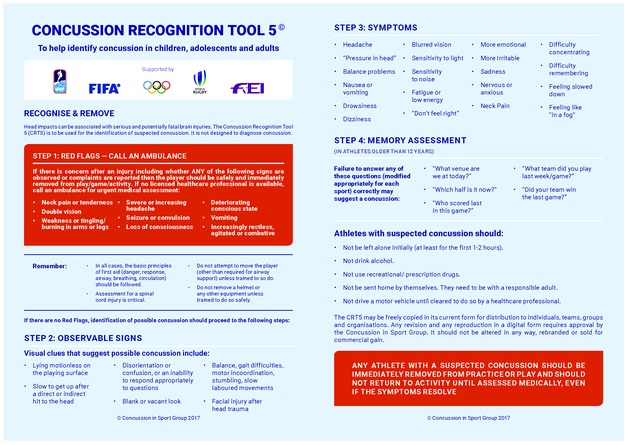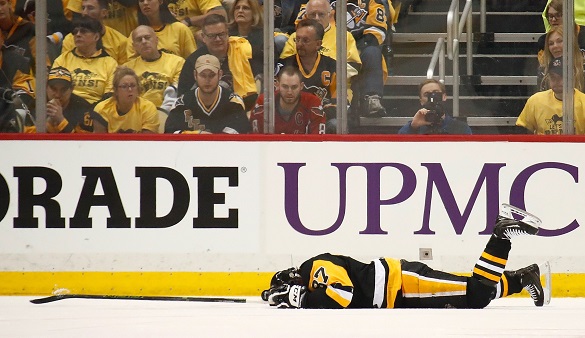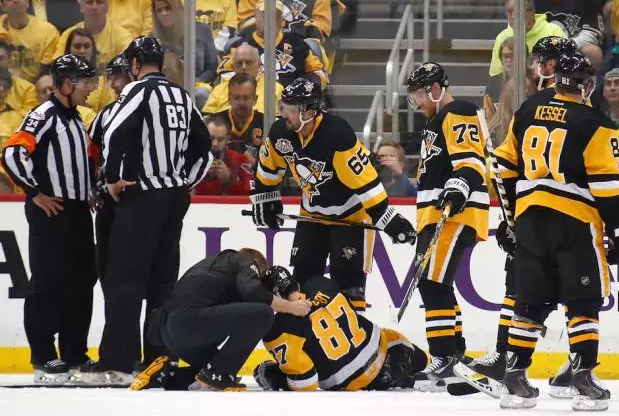Unsurprisingly, Sidney Crosby was a major focal point in the Penguins traditional springtime triumph over Washington in the Stanley Cup playoffs. However, it was what happened to him, rather than what he did on the ice, that was his main story. Crosby suffered a concussion as a result of a cross-check to the head by Matt Niskanen in Game 3 that forced him out of that contest as well as the next one. In Game 6, Crosby tumbled head-first into the bottom of the boards behind the Washington net but remained in the game, leading many to wonder whether the Penguins bent the criteria of the NHL/NHLPA Concussion Protocol in order to keep their star on the ice in a potential clinching game.
There were two main reactions to Crosby’s health and medical status during the series, both involving skepticism: 1) that the duration of only four full days of rest (and only one missed game) meant Crosby did not suffer a concussion, but some other injury, and 2) that it was hard to believe that none of the dedicated personnel – the Pittsburgh medical and training staff, Central League Spotters or In-Arena League Spotters – determined that Crosby suffered another concussion in Game 6 after his head hit the boards late in the first period.

Addressing the first point, concussions remain one of the most enigmatic phenomena in medicine. Like fingerprints, no two concussions are alike in terms of their visible symptoms and time required for recovery. A broken bone, torn ligament, torn muscle or even a malignancy has a fixed schedule for treatment, rehabilitation and recovery based on the history of thousands of past similar cases. Yet injuries to the brain still remain the great unknown.
Why do some hockey players absorb hits to their heads without injury while others are diagnosed with concussions? And of those with concussions resulting from similar head trauma, why do some players recover faster than others? Why do some concussions cause lingering symptoms for months while others of similar intensity head trauma only cause symptoms for days in the same player? Even the foremost neurologists and concussion researchers cannot give conclusive answers.
[youtube https://www.youtube.com/watch?v=YjDF1Saryg4]Certainly in Game 3, Crosby definitely showed 2 of the 6 signs that required his immediate removal for evaluation according to the language of the Concussion Protocol. He “[laid] motionless on the ice or [fell] to the ice in an unprotected manner,” and he “was slow to get up following [his] head making secondary contact with the ice.”
Also, Crosby’s initial inability to rise up from a prone position and his labored, bent-over skating off the ice while being assisted by head athletic trainer Chris Stewart, was an indicator of balance and coordination difficulties, another sign of a concussion. There was no other injury on the play despite the twisted appearance of his lower left leg when he fell.

Obviously, no one outside the Penguins locker room or medical staff knows for certain whether or not Crosby’s head hitting the boards in Game 6 resulted in another concussion. Unlike those on Twitter and other social media who thoroughly embarrassed themselves by magically performing an examination of Crosby remotely over the internet, diagnosing him with a second concussion, let’s work on the assumption that the Penguins actual medical staff correctly permitted him to safely continue playing in Game 6.
Yet even with the Concussion Protocol and the stringent Sport Concussion Assessment Tool (SCAT) tests in place plus independent League Spotters providing a second check for concussion signs, no process can eliminate a team’s desire to win at all costs and a player’s competitive desire to play at all costs – even if the price is his long-term neurologic health.
[youtube https://www.youtube.com/watch?v=u0Vdzawf9E8]What if Penguins team doctor Dharmesh Vyas, prudently considering the concussion suffered one week earlier, strongly advised Crosby during the first intermission of Game 6 to rest? Can you imagine Mike Sullivan’s reaction? Doc, it’s a chance at home to close this out… now he can’t play for me? He didn’t have to go through the Protocol, so what’s the big deal? Crosby himself, as captain and leader of the Penguins, irrespective of possible pressure from the coaching staff (or his teammates) would likely already be walking back down the tunnel toward the ice.
Is it worth it?
For us fans and bloggers in the crowd, we cringe when Crosby’s head snaps back and hits the ice, thinking that it’s crazy to only take one game off to recover. Yet for him, that one fleeting chance to hoist the Cup again can be irresistible even if all the concussions and all the sub-concussive hits to his head add up to something horrific in the long-term.
For obvious reasons, hockey will never eliminate head injuries completely but thankfully, we are at a point where there are NHL rules against hits to the head (long overdue) and a Concussion Protocol that mandates a thorough neurologic assessment.
Here’s hoping that further research leads to better understanding of the science of concussions and in turn, better protective equipment in hockey, better diagnostic tools for doctors and better treatment programs to get players back on the ice without shortening their careers or jeopardizing their long-term brain health.
Add The Sports Daily to your Google News Feed!
